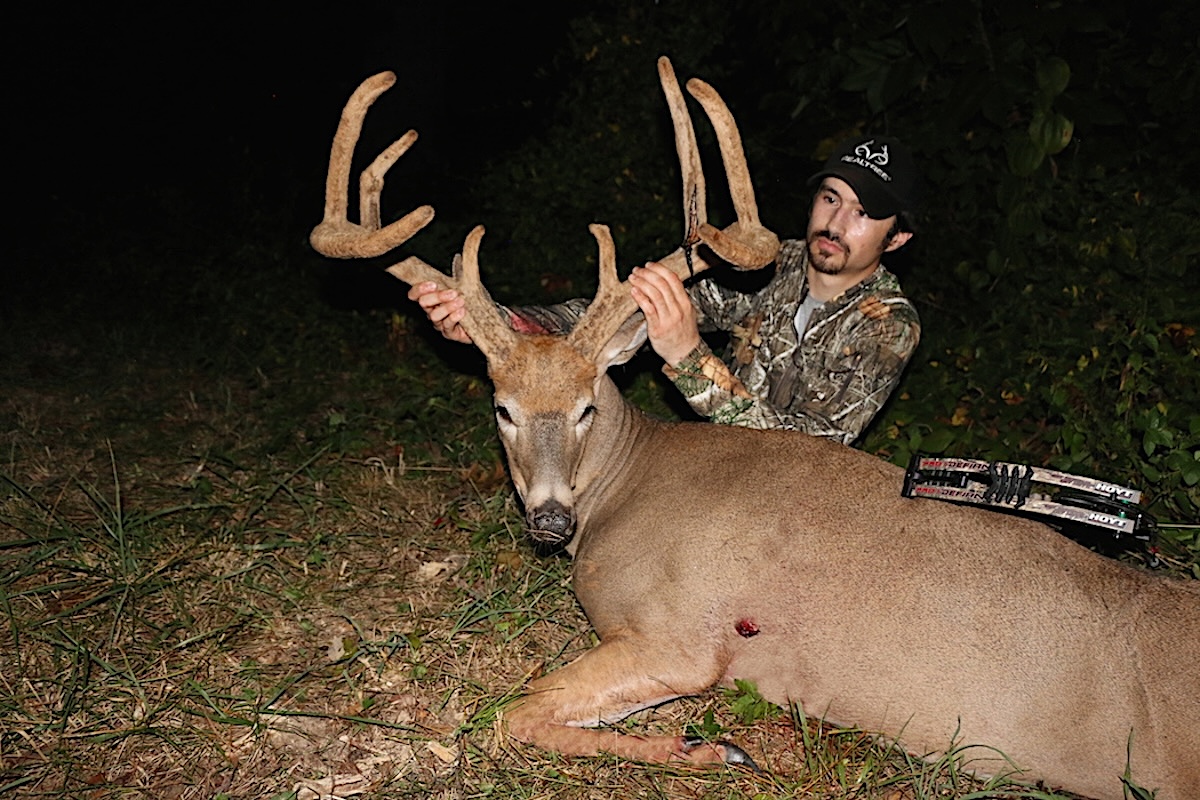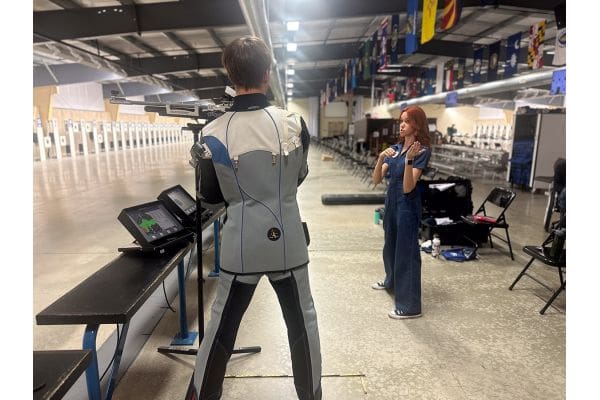That 164-inch velvet 8-pointer looked like an extinct Irish elk as he stepped out of the cedar thicket. His rack swayed back and forth as he scanned the landscape. My first hunt for that giant buck resulted in a sighting, but no shot opportunity.
However, I was just fine with that. It was meant to be an observation sit anyway, and it helped reveal that buck’s early-season pattern. The next day, I pushed further in and arrowed that massive sucker. He’s the biggest velvet 8-pointer I’ve ever killed.
Without a doubt, running trail cameras, studying lines of deer movement, and reflecting on history helped me kill that buck, along with several other early-season giants. From Kentucky to Ohio to South Dakota, I’ve done lots of early-season whitetail hunting, and I’ve found that it starts to get really fun once you’ve got a good buck patterned. When you don’t, it can make for some long, boring, sweaty sits.
Any time that I’ve had success in the early season, I’ve used at least one (or all) of the following 15 strategies to pattern a buck.
E-Scout with a Purpose
Photo by Josh Honeycutt
Start by e-scouting. Whether using digital maps or apps, such as HuntStand, scour your hunting properties from above. This will provide a great starting point and likely shorten the scouting curve. Use scouting tools to locate some of the key locations outlined below. E-scouting also helps you avoid spooking the buck you intend to hunt. Accidentally tromping through his bedding area now will only make him that much harder to pattern and kill.
Reflect on Past Scouting Notes
Study intel from past seasons. Pay close attention to trail camera photos, scouting notes, and harvest results from years where the crop rotations and other property conditions match this year’s. Barring large landscape changes, it’s likely the general deer herd will behave in a similar manner. You should also study past scouting notes for specific target bucks. This can produce viable intel as to how a specific buck might behave again this season.
Pinpoint the Best Grub

Photo by Josh Honeycutt
Early-season whitetails carry over their pre-season habits, and much of their activity revolves around food sources this time of year. In some cases, they’ll forgo prime bedding cover in order to bed closer to the best food. Search for these early-season food sources, such as green soybean fields, freshly cut cornfields, pockets of white oaks, clover food plots, and more. Use trail cameras to identify the hottest food sources at the time. And don’t be afraid to move cameras to new locations when they’re not capturing photos.
Read Next: What Do Deer Eat
Find Early-Season Bedding Cover
Early-season bedding cover is usually located directly adjacent to the best food sources. That said, mature deer are smart, and they’ll bed in advantageous places even during the early season. They’ll typically choose bedding cover that provides cooler conditions. Generally, these are near water, in areas with good open-canopy airflow, and in low-lying areas. In hilly country, and especially if it’s warm, they’ll seek out cooler northern-facing slopes.
Locate Isolated Water Sources
Locating water sources can be a great play, especially on properties where water is limited. Oftentimes, deer hit these reliably. And even if deer are coming to water after dark, watering holes become predictable waypoints in day-to-day lines of movement that you can use to connect the dots. The more you can find out about a buck’s movement, the better. Interestingly, deer often like to drink out of smaller, muddy puddles, not always the pristine streams or lakes you might imagine.
Run Some SD and Cell Cams
With a decent understanding of how deer are using the property, it’s time to hang trail cameras — a bunch of them. Place SD cams in locations you can check without alerting deer. Deploy cell cameras in your best spots where you don’t want to apply pressure while pulling cards. Pair cell cams with external battery sources to ensure they last longer.
Read Next: Best Cellular Trail Cameras, Tested and Reviewed
Anticipate Food Source Shifts
Food sources don’t remain the same as summer turns to fall. So anticipate these shifts as bucks move from one source to the next. Typically deer transition from green soybean fields to falling white oak acorns at some point in early fall. Anticipate that change and hunt where the deer are going to be, not where they used to be.
Pay Attention to Early Rubs
Hunting a rub line doesn’t always produce results. But a strong series of rubs might. That’s especially true for heavy rub lines that connect bedding areas and food sources. Use these to recognize lines of buck movement.
Juice a Mock Scrape
Where legally permitted, juicing a scrape or creating a mock scrape can influence deer, too. Using deer scent can help pull bucks in front of cams, stop deer for shot opportunities, or maybe encourage a buck to use your trail instead of another 20 or 30 yards away. Here’s everything you need to know about mock scrapes and rope scrapes.
Sit Observation Stands
One of the best early-season tactics is hunting from observation stand locations. This is essentially a stand site that lets you see a large area and will help you pinpoint deer movement. The odds of killing a target buck from these spots aren’t great, but they can give you the needed information to move in and fill a tag on the next outing or two. It’s a safe way to collect intel from afar without alerting deer to your presence.
Put a Buck to Bed

Photo by Josh Honeycutt
Don’t want to burn the first afternoon or two of deer season sitting in observation stands? That’s fine. Use the less-valuable morning hunts to sit observation stands. This way, you can potentially watch a buck as it leaves ag fields or larger food plots. Mark where it heads back into the timber, and then you’ll have an idea of where to post up for the afternoon sit. Just make sure you have a good way of getting into your morning spot without spooking deer.
Focus on Good Weather Days
A good weather front, rain event, or temperature drop can spark deer movement. Pinpointing these conditions in the upcoming forecast increases your odds of seeing deer during legal light, especially target bucks. It ups the likelihood of success, and it definitely makes for a more enjoyable hunt than sitting through a blistering hot afternoon.
Stay Undetected
Aside from consistent, reliable bed-to-feed patterns, the major benefit of early-season deer hunting is a lack of hunting pressure. You want to keep it that way (whether you’re hunting public or private ground) by staying undetected during your scouting and hunting efforts to maintain this advantage.
Remain Mobile
Bucks change their patterns, especially when they drop their velvet. You might see a buck consistently all summer only to have him seemingly disappear right before the opener (that’s pretty common, actually). If and when you see a pattern shift, it’s crucial to shift with it. Remain mobile and be ready to hunt different spots as deer transition to new areas, fresh food sources, and into their fall ranges.
Don’t Spook the Does
Finally, understand that early-season hunts tend to produce a lot of deer sightings. Generally, the parade of deer consists of does and fawns, younger bucks, and then older bucks (in that order). You must survive those first waves of deer to get a shot at the big bucks that take up the rear. So think carefully about wind direction when choosing your setup. You’ll likely have to remain undetected while does and younger bucks feed around you. Do that, and all that’s left is making the shot.
Final Thoughts on Patterning an Early-Season Buck
Despite all the good that comes with early-season deer hunting, there are challenges to anticipate and overcome. Food source shifts are big. So is hunting pressure, which will increase as more folks get out in the woods. And eventually, bachelor groups will begin breaking up. You’ll have to roll with these challenges while you execute the game plan above. But if you’re able to adapt effectively, you just might kill the early-season buck of your dreams.
Read the full article here




